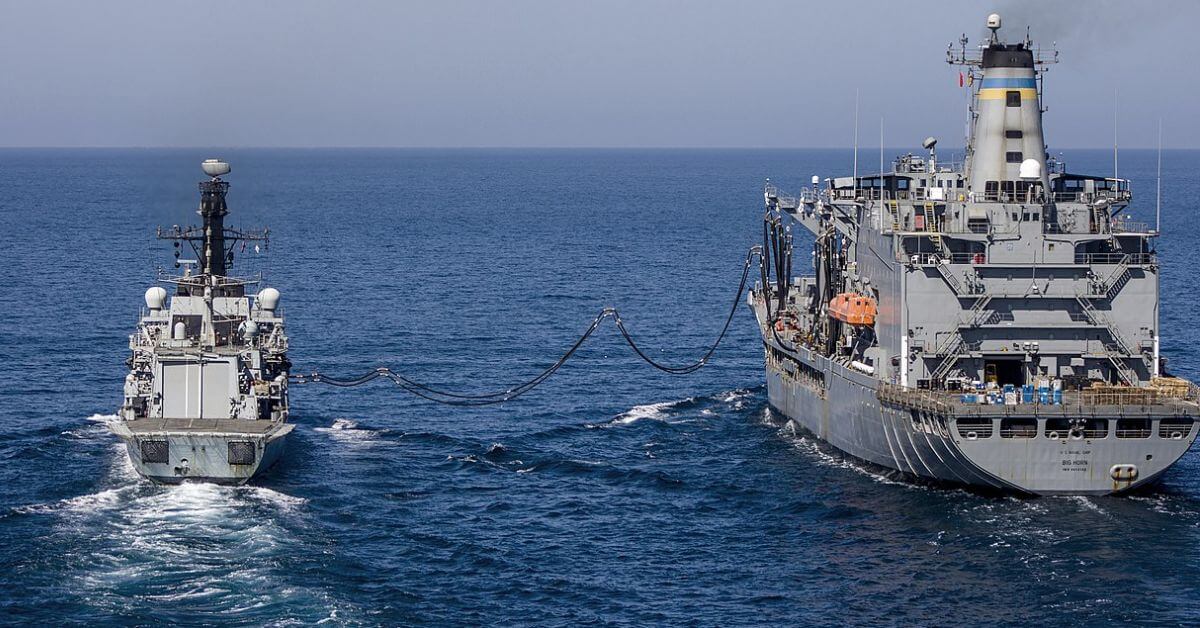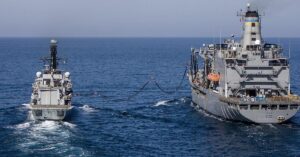
Russian Navy Warship Fires Warning Shots At Norwegian Fishing Vessel In Arctic Ocean
September 25, 2024
Container Loaded With Lithium-Ion Batteries Catches Fire At Port Of Montreal
September 25, 2024

The U.S. Navy replenishment oiler, USNS Big Horn, ran aground and partially flooded off the coast of Oman on September 23, 2024. The situation left the USS Abraham Lincoln Carrier Strike Group in urgent need of fuel.
A video circulated on social media from inside the ship showed damage to the rudder post and water entering a mechanical compartment.
Although naval vessels do not send out AIS signals, a source verified that the Big Horn is anchored close to Oman and awaiting a thorough damage assessment.
All 80 crew members aboard the ship are safe, and no injuries or environmental damage have been reported.
A U.S. Navy official stated that the USNS Big Horn sustained damage while operating in the U.S. 5th Fleet area of operations.
The ship is one of the oldest Kaiser-class oilers, and it has been crucial for refuelling carrier strike groups at sea since the 1980s.
These single-hull tankers have been criticized for their environmental problems, leading to the adoption of double-hull designs in modern vessels.
The Big Horn is the only oiler deployed in the Middle East, which further intensifies the situation. The Navy is trying to find a commercial oil tanker to provide jet fuel to the USS Abraham Lincoln.
It’s not looking good. I’ve been told by a shipowner the Navy does not have a spare oiler to deploy and is scrambling to find a commercial oil tanker to refuel the Abraham Lincoln carrier group.
Updates over at gCaptain forum: https://t.co/nNG6uSYGJJ https://t.co/wGP2GTYyAw pic.twitter.com/ec2oN3CpSf
— John Ʌ Konrad V (@johnkonrad) September 24, 2024
Video Credits: John Ʌ Konrad V/X
If this happens, the commercial vessel must be modified for safe refuelling operations, including installing specialized equipment and training a U.S. Merchant Marine crew.
The Navy has been facing a major shortage of oilers and crew members.
The officials have revealed plans to lay up 17 replenishment and supply ships, including one oiler, due to problems recruiting U.S. merchant mariners.
The Navy is set to launch the new John Lewis-class oilers, but there are rumours that these ships are having issues and delays, leaving none of them prepared for an overseas deployment.
Industry experts have said that the Department of Defense needs over 100 tankers to maintain operations in conflict zones, especially in the Pacific. However, according to reports, the Department of Defense has access to less than ten tankers, which could threaten military effectiveness.
Military officials have stated that the Navy might need to transfer fuel between vessels to continue its operations in the region.
The Navy has maintained a presence in the Middle East to protect US interests and deter regional threats, especially as tensions rise due to Israel-related crises.
The investigation into the grounding of the USNS Big Horn is underway. Officials have stated that it is too early to determine the exact cause of the incident.
The Big Horn is currently being towed for assessment and repairs.
Reference: Military.com, Washington Post
U.S. Navy Oiler Sustains Major Damage & Runs Aground Off The Coast Of Oman appeared first on Marine Insight – The Maritime Industry Guide
Source: Maritime Shipping News


